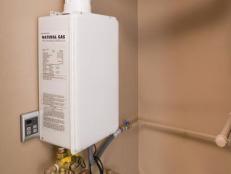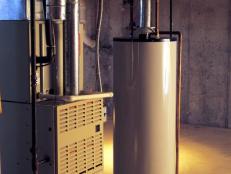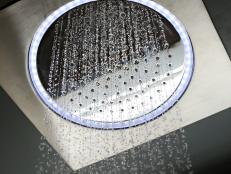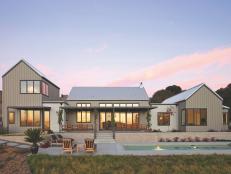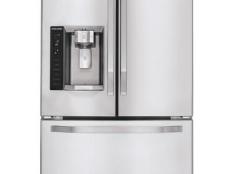Hot-Water Heater Buying Guide
Learn about the different types of hot-water heaters, which are the most energy efficient and how to get money back in federal tax credit.
It’s the morning bathroom stampede, and you’re last in line. Again. A disheartening, tepid shower awaits.
That’s just one of the scenarios that may have you thinking about a new water heater. Need more reasons? Beating back high energy bills, or maybe your water heater is past its life expectancy of 10 to 15 years and you’re pushing your luck.

Julia Nichols
If you’re ready to upgrade, there’s good news. There are a lot of choices when it comes to fuel options and sizes for water heaters, plus improved technologies that save on energy costs.
No matter what you decide, keep in mind that heating water takes a lot of energy. In fact, the average household spends some $400 to $600 per year on heating water. Put another way: nearly 20 percent of your total energy bill goes down the drain in the form of hot water.
So keeping energy efficiency top of mind while you shop is a good idea, and will probably save you money in the long haul. Plus, the most energy-efficient water heaters may be eligible for a federal tax credit.
Types of Water Heaters
Storage tank water heaters are the most common type and are available in a range of storage capacities from 20 to 80 gallons. Cold water enters the storage tank and is heated by either gas or electricity. The water stays hot at a set temperature until it’s needed.
Pros: Storage tank heaters generally are the least expensive types and operate faithfully with a minimum of maintenance.
Cons: The stored water slowly loses heat and must be continually reheated to the set temperature, wasting energy.
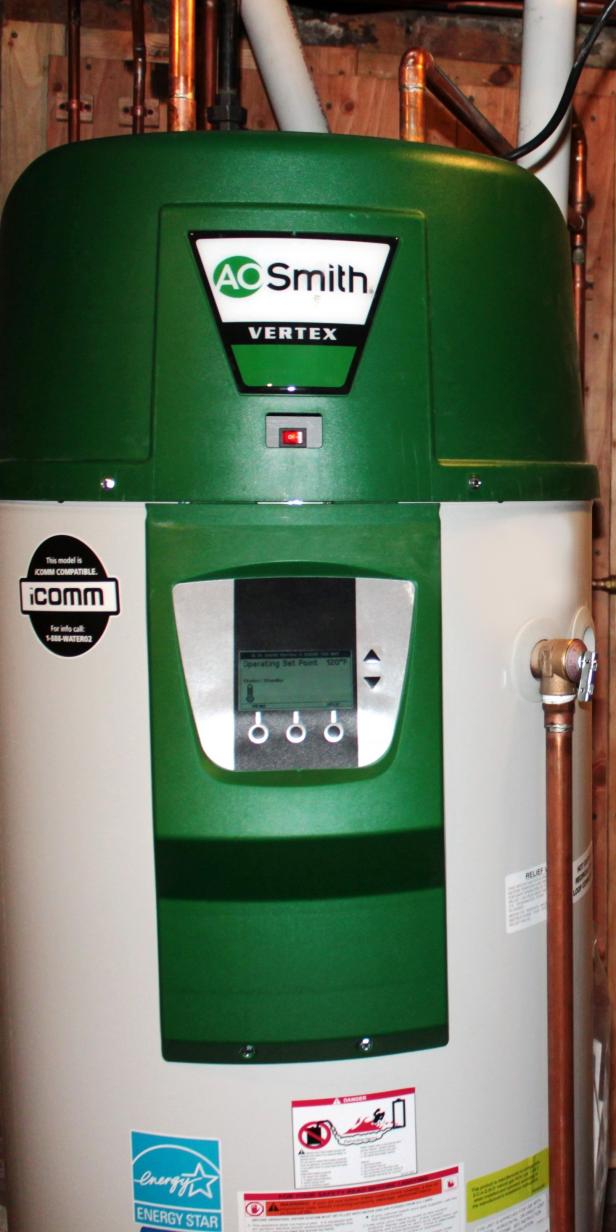
AO Smith
Tankless water heaters, aka on-demand or instantaneous water heaters, don’t have any storage capacity. Instead, when someone turns on a hot water faucet or the dishwasher, cold water flows into the tankless unit, gets heated to a set temperature, then is piped to wherever it’s needed. Tankless units come in various sizes depending on the size of the household.
Pros: Tankless water heaters are more energy efficient than storage types, and you’ll never run out of hot water.
Cons: They’re more expensive than a conventional storage type, and installation can be tricky, driving up initial costs. Depending on the size of your house and household, you may need more than one.

Rinnai
Hybrid heat pump water heaters take warmth from the ambient air and use it to heat water inside a storage tank. Hybrids feature supplemental electrical heating to handle periods of high demand.
Pros: Because heat pump type water heaters use air that’s already warm, they’re very energy efficient — up to three times more efficient than conventional storage type heaters. Energy Star-qualified heat pump water heaters can save an average household up to $300 per year in energy costs.
Cons: These types of water heaters have special requirements. They need lots of unobstructed space around them so they can work efficiently, and they can only be installed in climates where the yearly temperature range stays between 40 to 90 degrees. However, some models include switchable modes, meaning you can shift to a standard, all-electric heating mode if temps are too low.
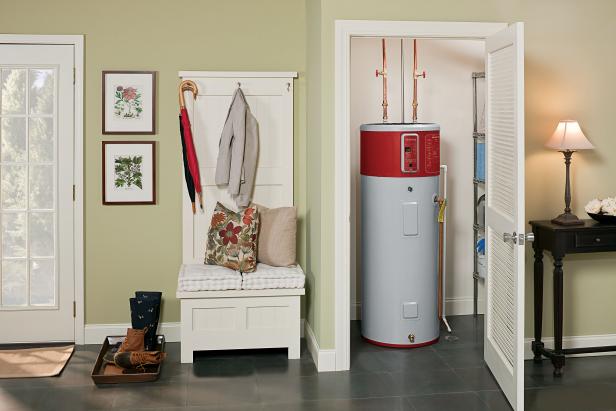
GE
Solar water heaters feature a collector — a flat box that’s usually installed on your roof. Tubes inside the box circulate cold water, and heat captured from sunlight warms the water as it circulates. The warmed water then returns to a storage tank. Thermostatic controls prevent water from flowing when outside temps are very low. The tank itself usually includes a conventional, supplemental heat source to keep up with demands.
Where freezing temps are common, an indirect system is better. Instead of heating household water directly, the unit circulates an antifreeze solution. Sunlight heats the antifreeze as it moves through pipes inside the collector. Then the warmed solution moves through a heat exchanger — often a simple series of coils — inside a hot water storage tank.
Solar water heaters qualify for a federal tax credit of up to 30 percent of the installation costs in 2016. To qualify, your hot water heating system must generate at least half its heat from the sun.
Pros: Sunshine is a free and renewable resource. Tax credits shave installation costs.
Cons: Initial setup increases costs, especially if running pipes from the collector to a storage tank is problematic. A backup heat source is usually needed to compensate for very cold or cloudy days.
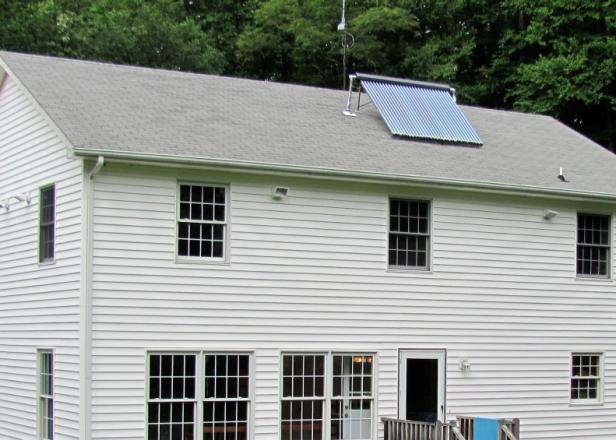
Solar Energy Industries Association
Gas or Electric? (Check the EnergyGuide)
The answer to that question depends on what type of fuel is available in your area and specifically, to your home. In some areas, propane or fuel oil substitutes for natural gas.
If you have the choice, it’s wise to compare the annual operating costs of the appliance. Check your local utility company for current rates.
You’ll want to balance annual operating costs with the initial cost of the water heater. Some of the cheapest models might be attractive from a budget point of view, but actually end up costing you more over the life of the appliance due to higher annual operating costs. If you plan to retrofit to a model that uses gas, propane, or oil, remember that you’ll need to vent the unit to the outside, which adds initial cost.
You can get a fair idea of yearly operating costs by checking the yellow and black, federally mandated EnergyGuide label that’s attached to all new appliances. The annual cost figure is an estimate based on national averages, but it’ll allow you to compare models easily.
One good way to ensure you’ll get low annual operating costs is to look for water heaters that carry the Energy Star label. Energy Star appliances are certified to be highly energy efficient and save money over the life of the unit. Plus, many Energy Star water heaters qualify for state and local rebates.
How Big Should Your Water Heater Be?
Determining your water heater needs to be can get a bit tricky, and professional installers use mathematical formulas that depend on the type of water heater, the size of your household, and an estimate of your daily usage.
Your appliance dealer should be able to help you determine the capacity and size of water heater you’ll need. You can start by figuring out how much hot water your household uses at peak times. If your family does three showers, a shave, and breakfast prep first thing in the morning, that’ll help determine the size of your new water heater.
For storage-tank type water heaters, that figure is called “first-hour rating,” or FHR. For tankless heaters, it’s know as “flow rate.”
If you’re a numbers nerd and want to do the calculations yourself, visit the Department of Energy’s webpage on sizing a new water heater.
Speaking of “Big”
In 2015 the federal government mandated new guidelines for the energy efficiency of new water heaters, which include the effectiveness of tank insulation. One result is that some new tank type heaters got fatter. So, if you’re thinking of replacing your old 50-gallon water heater with a new 50-gallon model, be sure to measure the available space to ensure the new water heater will fit!
Tax Credits for Water Heaters
Every year for the last several years the feds have decided to let certain energy tax credits expire, only to rescue some at the last minute. This year is no different, and the tax credit that applies to non-solar water heaters is set to expire at the end of 2016.
In order to qualify, your water heater must meet or exceed certain standards of energy efficiency, known as an “energy factor” or “thermal efficiency.” You can find those figures in the literature provided by the manufacturer.
Gas, propane, and oil-fueled water heaters must have an energy factor equal to or greater than .82, or a thermal efficiency rating equal to or greater than .90.
Heat pump water heaters must have an energy factor equal to or greater than 2.0.
Qualified non-solar water heaters installed in 2015 or 2016 are eligible for the federal tax credit for non-solar water heaters. The total max amount you can claim for a water heater is $300, but if you’ve already claimed an energy tax credit of in previous years, your new purchase might not be eligible.
Homeowners who install a solar water heater may claim a federal tax credit for solar water heaters of 30 percent of qualified expenditures for systems placed in service by the end of 2019.








